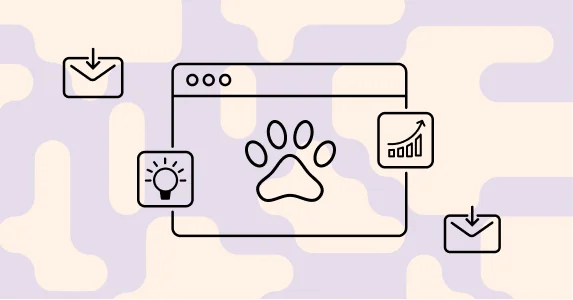According to the Business Research Company, the BFSI (Banking, Financial Services, and Insurance) industry is projected to grow from $59.66 billion in 2023 to $66.61 billion in 2024. In this highly competitive landscape, individual banks and finance and insurance houses must keep up with the times (and technology) to stand out and offer better service to their customers.
As all things go, promotional push notifications and SMSes are becoming less dependable as customers ignore most marketing communication due to content fatigue. They also expect hyper-personalized levels of service, convenience, and meaningful interactions.
Marketing technology in BFSI has started meeting these expectations with Inbox Commerce and its cutting-edge capabilities.
This article decodes Inbox Commerce (comprising RCS, WhatsApp Business, and AMP for email) and its efficacy in engaging and converting customers in the BFSI sector.
What is Inbox Commerce?
Inbox Commerce is the practice of marketing products/services, engaging with customers, and conducting transactions right inside emails and messages (SMS and WhatsApp).
This approach focuses on simplifying the customer experience to make it convenient for users to connect with brands. They can effortlessly buy products/services without too many redirects to sites and apps.
A typical example would be RCS communications showcasing products and letting users choose and pay within the message. Similarly, brands can use a WhatsApp Business Account to offer their entire product catalog (for example, fund options presented by an investment firm) and accept payment of premiums within the WhatsApp message.
At the heart of Inbox Commerce are three technologies – RCS (Rich Communication Services), WhatsApp Business, and AMP for email. They comprise the foundation of Inbox Commerce and are fast becoming the most influential tech combo for unconventional marketing and conversion in the BFSI industry.
Let us have a look at some marketing use cases for Inbox Commerce in BFSI:
RCS (Rich Communication Services)
RCS is an advanced messaging protocol to enhance text messaging and multimedia communication on mobile devices. It is a telecommunications industry standard developed and supported by the world’s most powerful mobile network operators, device manufacturers, and technology giants, including Google.
RCS turns the otherwise ‘bland’ SMS into a multi-functional marketing tool. Brands can use RCS messages to initiate and continue two-way conversations with customers, which is a great deal for both parties.
BFSI brands can leverage RCS features like read receipts, typing indicators, group messaging, and sharing high-quality images, videos, FAQs, chatbots and files. As for users, they get to enjoy an interactive and feature-rich experience on their message screens without downloading another app.
Several surveys and studies have shown that 70-80% of consumers would like to engage with businesses through private messaging rather than promotional emails and banner ads. However, SMS only offers one-way communication, allows no visuals, and limits text to 160 characters. RCS is the perfect solution – businesses can send customers rich, contextually relevant content.
Here’s how RCS can help banks and financial houses amplify their marketing ROI:
Interact directly with customers to understand their preferences
All the market research in the world cannot equal the information given by customers directly. RCS messages make collecting details simple by letting marketers initiate one-on-one conversations that resonate with customers.
For example, an investment firm wants to understand how to better serve their highest-income clients with products and services. They can start a conversation using RCS messages and create in-message forms (with multiple-choice questions and/or text boxes) that help clients answer questions on the go.
RCS messages talk to the users directly and convey that the brand genuinely seeks to understand what they want from their engagement. RCS helps create positive brand associations and curate products and services that customers readily accept.
Meet customer expectations for rich, dynamic content
In a world of rich, dynamic content, people just don’t respond as well to regular text as they see in regular SMS. They expect content to be eye-catching, intuitive, easily consumable, and, above all, helpful.
RCS offers many features, including high-res images, videos, GIFs, moving menus, collapsible headers for extra information, and more. RCS messages provide all the functions of a website or app within a message in the SMS inbox.
Enable customers to accomplish all necessary actions (purchase, investment, checking account balance, searching for suitable financial plans, etc.) within a single message. Bring convenience into the equation, and conversions will inevitably increase.
Gather valuable data about customer interactions and impressions
RCS messages allow the brand to get valuable analytics data. Marketers can identify open rates, time taken to respond, the sentiment of the response, read receipts, and more. They can search for specific keywords to determine if there are any commonly perceived issues associated with the responses.
This data is precious when it comes to personalization and optimization. Brands can use it to derive insights into what messages/products/services work best and what repels the customers. How fast customers respond after seeing the message strongly indicates its efficacy and can help marketing, content, and customer service teams up their game.
WhatsApp Business
With WhatsApp Business, brands can communicate directly with their customers on a platform generally used for casual conversations. With 2 billion users and a 98% open rate, WhatsApp provides the ideal channel on which marketing messages are noticed and explored by customers.
Like RCS, WhatsApp Business aims to establish a direct, personalized two-way line of contact between brands and buyers.
Brands can use WhatsApp to send promotional messages, updates, and offers, providing a more targeted and real-time connection with their audience.
One of WhatsApp’s most notable features is ‘Click to Chat.’ Marketers can integrate a direct chat link on a brand’s websites or social media platforms so that users can access the official WhatsApp channel with a single click.
If a brand has to send particular messages to specific groups of users (based on customer segmentation) instead of individual customers, they can use the WhatsApp broadcast lists. For example, broadcast is the ideal feature to send marketing recommendations for insurance plans to customers based on their age group, income, and premium amount parameters.
Brands can also implement payment mechanisms within WhatsApp messages so customers can make payments with a few clicks, without getting redirected to a website or app.
Here’s how WhatsApp Business can help accelerate conversions for BFSI brands:
Speed up loan searches and approvals
HDFC, one of India’s leading housing finance providers, created a ‘spot offer’ option on their WhatsApp Business Platform. Customers could quickly look through a menu of options and use the function of the offer to calculate their eligibility. They could do so via a guided conversational flow and receive a conditional home loan letter based on the information provided.
The results:
- 25% of customers engaging via WhatsApp completed the spot offer process.
- 13,000 high-quality leads were attributed to WhatsApp in less than a year.
- 85,000+ unique users interact via WhatsApp every month.
- The number of users who completed the loan application via WhatsApp was twice that of users from other channels.
The sheer versatility of WhatsApp Business makes it ideal for BFSI marketers and product managers to create communication flows that encourage ease and conversion.
Disseminate essential information with ease
During the COVID-19 pandemic, South Africa’s Standard Bank used the WhatsApp Business chatbot to provide customers with accurate information on the bank’s COVID-19 policy, service availability, financial support for COVID-stricken businesses, and the bank’s contribution to government relief efforts.
Banks can use the same features to update users with essential information about financial regulations, changes to existing funds, and security practices.
Follow up with potential customers and/or investors
If a sales agent has just met with a potential customer, they can follow up via WhatsApp. Create a personalized message, and reach out to the individual with a summary of the meeting, any relevant documents they requested, and final confirmation for a policy signup or the next meeting.
Invite the customer to clarify any doubts that might have cropped up after the meeting. Since brands can directly converse with the individual, the customer can just type in the questions as in a regular WhatsApp conversation.
Enable easy money management
Way back in 2016, Goldman Sachs rolled out Marcus, its digital-only bank, which was essential for the firm’s consumer banking expansion. This platform helped customers connect the Marcus account to their existing bank account and use the Marcus mobile app for mobile banking. Cut to the present, WhatsApp Business is the next stage in the evolution. Instead of downloading another app, users can access all digital banking features on a messaging platform that they use multiple times daily.
With WhatsApp Business, customers can check their account balances, look up local ATMs, stay updated on interest rates, set credit limits, and more.
AMP for Email
AMP for email allows brands to embed regular emails with website and app-like features. AMP emails let users accomplish many of the actions for which they would have to visit a site or download an app – searching for products or services, ordering them, completing payments, filling in forms, sharing feedback and reviews, redeeming offers, finding branch/ATM locations on maps, and so much more.
AMP emails help users get the best out of a business interaction without navigating to any website or app. No redirects from email. No lead leakage. Lower bounce rates. Better user experiences.
BFSI businesses can use AMP for email to further their marketing goals within the BFSI domain in the following ways:
Offer educational content based on customer preferences
Once customers specify their priorities and preferences, start sharing content related to their interests. Let’s say someone has been looking up different mutual funds on their banking/finance app. Brands can send articles/videos on selecting suitable funds, determining the risk-reward ratio for their investments, etc.
Marketers needn’t worry about too much text cluttering up screens. AMP emails come with components to arrange big chunks of text into collapsible sections, which customers can choose and expand one by one. Businesses can also highlight any product matching the customer preferences within this content.
Use gamification to break the ice
BFSI content is often formal and dry, as it deals with money and financial planning. AMP emails can make learning about financial products and services enjoyable for customers.
Brands can make educational content more fun with simple quizzes at the end of a section. It will also enable them to interact and engage with customers in a non-transactional manner. Gamifying the offers can make the emails unique and compelling.
Compare products to help users decide
Most customers do not purchase the first product they see. They conduct their research, compare providers, read reviews, consult friends, and then decide. If businesses want to truly connect, they should help customers make an informed decision.
Businesses can do a lot with AMP emails: showcase all products and options in a multi-image carousel that users can swipe through; display detailed comparisons between their offerings and other market options; establish that they are the better choice through hard facts and numbers.
AMP emails can also carry embedded calculators that help customers determine the monthly payments, final payout amount according to different interest rates, and bonuses, etc.
Provide updates about fund performance and market status
AMP emails can tap into a system’s backend and automatically extract relevant, updated information to showcase in the email body. They are exceptionally useful for displaying to-the-minute data on market dynamics and individual fund performance. No matter when a user opens the email, it always shows information updated in real-time.
Users can open an AMP email and get the current details of how their money and the money market are doing. As the data is always up to date, the email is all they need to stay informed about their financial health.
Making lives easy is the key to getting closer to customers
Banks can now bring unprecedented customer convenience, cutting-edge features, and instant query responses to customers’ favorite messaging channels with Inbox Commerce. By enabling essential commercial functions within RCS, WhatsApp Business, and AMP for email, BFSI establishments can offer ease of use and have two-way communications with customers.
Connect with us to understand how Inbox Commerce can boost your ROI. Let’s talk about how you can leverage our expertise and experience in Inbox Commerce to leave competition behind.
Serving over 6,500 customers across 40 countries, Netcore delivers over one billion inbox experiences every day – including 500 million emails and 700 million push notifications. Netcore’s AI is trained on 25 billion+ interactions from 1,300+ stores, making it an invaluable asset for BFSI brands looking to find the early-mover advantage with Inbox Commerce.










